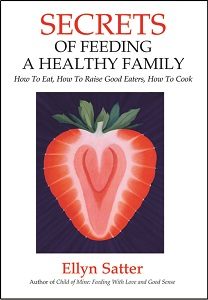

Family Meals Focus
The Ellyn Satter Institute Newsletter
Eating Competence: A Game Changer in Your Nutrition Practice
by Ellyn Satter, MS, MSSW, Dietitian and Family Therapist
Click here for a PDF of this newsletter
If you are a student dietitian, or even an experienced professional, you may struggle with regard to practicing the Satter Eating Competence Model (ecSatter)1 and the Satter Feeding Dynamics Model (fdSatter)2 in a conventional world. Practicing based on ecSatter and fdSatter means supporting people in being joyful with food, rather than teaching them what they should and shouldn’t eat and how much they should weigh. You may worry that you will be ostracized for your liberal stance, and fear that your patients will simply go out of control with their eating. You may wonder, in fact, whether it is safer to teach modified diets, especially to people who have diseases.
Conventional practice assumes dietary prescription is best
It isn’t easy making the transition from conventional practice to the trust models, fdSatter and ecSatter. National nutrition policy is a control approach, and the Dietary Guidelines are food-prescriptive. One of the biggest obstacles to effective nutrition education and clinical practice as well as to realistic and practical national nutrition policy is the assumption that food prescriptiveness is superior to Eating Competence (EC) with respect to achieving nutritional excellence and wellness. It isn’t. Prescriptive diets and the Dietary Guidelines which are essentially a blueprint for prescriptive diets, do not produce target results in large-scale studies.3,4,5 Worse, those diets destroy joy and ease in eating, engender distrust of well-established and well-tested foodways, and precipitate distorted eating attitudes and behaviors. I used to give those diets, I created all that negativity in my patients, and I was stimulated by my own mistakes to develop ecSatter and fdSatter.
ecSatter and fdSatter rescue dietitians for the profession
Research shows Competent Eaters do better in all ways. Dietary prescriptiveness doesn’t match that.
Other Satter-model practitioners and I have found that helping people to be positive, joyful, and reliable with eating is way more rewarding than teaching dietary prescriptions. In fact, many dietitians have found conventional dietetics practice to be so demoralizing for them (and their clients) that they were ready to leave the profession. Practicing based on the Satter models gave them a whole new professional lease on life. Not only that, but they got better results than they ever had with conventional nutrition practice. Observational studies show that Competent Eaters do better nutritionally,6-8 do better with weight management (in that they stabilize their weights),7,8 have more positive eating attitudes and behaviors,8,9 and show better health indicators (blood lipids,7,10 blood pressure,7 and blood sugar10). They even do better socially and emotionally.8
Eating competence is a radical, not extreme or fanatic
Radical means “reduced to its simplest and most elemental form – of or relating to the root.” Since fdSatter and ecSatter are based on the theoretical and practical roots of dietetics, you can use your considerable expertise to be creative with respect to helping people find solutions to their food and nutrition challenges. That’s something you can’t do if you are simply handing out diets or even doing cognitive-behavioral intervention get dietary adherence. Consider the roots.
- Consider trusting food traditions and the social and emotional meanings of food. If you go back far enough, people in all cultures survived and developed their foodways by trusting their bodies, being tuned in to the environment, and finding ways that worked with food and with eating.
- Consider physiology, metabolism, and the body’s powerful homeostatic processes. Trusting homeostasis allows you to support clients in working with their bodies rather than against them based on their internal regulators of hunger, appetite, and satiety.
- Consider food chemistry, food composition, and nutritional principles. Rather than having to go by lists of dos and don’ts, you can think strategically when managing meals to support diabetes,11 evaluate fatty acid profiles of “forbidden” fats,12 and discover the nutritional value in foods your clients enjoy.
- Consider critical thinking and evidence-based practice. Rather than blindly adhering to nutrition policy, you can do as I did in this Secrets appendix: read and evaluate the literature, make up your own mind,13 and help your clients make their own informed decisions.
EC joins with people right where they are
EC respects and supports people’s foodways and emphasizes the ritual, dignity, and security of the family meal. (Keep in mind that you are a family when you take care of yourself.) When people feed themselves faithfully and give themselves permission to eat, they naturally learn and grow with food. Over time and to the best of their personal and financial abilities, they increase their dietary quality. If you are positive, supportive, and cognizant of the principles of the Satter Hierarchy of Food Needs,14 you might see openings to advise about food selection but be careful. If your advice undermines all-important positive eating attitudes and behaviors–if it precipitates shame and an on-again, off-again eating pattern–it is doing harm, not good. People do the best they can with their food, and they are not helped by being made to feel ashamed of what they eat.
You will encounter resistance from other professionals
Being a practitioner of ecSatter and fdSatter is not for the faint-hearted. It takes time, energy, and courage, as your colleagues may react with resistance and suspicion. You may feel, as one EC practitioner observed, “Sometimes I would just like to go back to telling them what to eat.” But let me be absolutely clear: You do have to choose. EC and dietary prescriptiveness are like oil and water: They don’t mix. If you try to blend them, you will confuse yourself and your clients and do more harm than good.
Your clients will love your EC approach
Your clients, on the other hand, will be surprised and gratified by your kinder, gentler ways with nutrition counseling and will evolve greater nutritional excellence and wellness. Whether I was doing nutrition education or medical nutrition therapy, I always felt best about practicing dietetics when I helped free people up to enjoy their eating. My wish for you is that you will find the same.
References
- Satter EM. Eating Competence: definition and evidence for the Satter Eating Competence Model. J Nutr Educ Behav. 2007;39 (suppl):S142-S153.
- Satter E. Part II: How to Raise Good Eaters. Secrets of Feeding a Healthy Family: How to Eat, How to Raise Good Eaters and How to Cook. Kelcy Press; 2008:55-87.
- Ebrahim S, Taylor F, Ward K, et al. Multiple risk factor interventions for primary prevention ofcoronary heart disease. Cochrane Database Syst Rev. 2011:CD001561. doi:10.1002/14651858.CD001561.pub3
- Howard BV, et.al. Low-fat dietary pattern and risk of cardiovascular disease: the Women’s Health Initiative randomized controlled dietary modification trial. JAMA. 2006;295:655-666.
- McCullough ML, Feskanich D, Stampfer MJ, et al. Adherence to the Dietary Guidelines for Americans and risk of major chronic disease in women. Am J Clin Nutr. 2000;72:1214-1222
- Lohse B, Bailey RL, Krall JS, et al. Diet quality is related to Eating Competence in cross-sectional sample of low-income females surveyed in Pennsylvania. Appetite. 2012;58:645-650..
- Lohse B, Psota T, Estruch R, et al. Eating Competence of elderly Spanish adults is as
- Lohse B, Satter E, Horacek T, et al. Measuring Eating Competence: psychometric properties and validity of the ecSatter Inventory. J Nutr Educ Behav. 2007;39:S154-S166.
- Stotts Krall J, Lohse B. Interviews with low-income Pennsylvanians verify a need to enhance Eating Competence. J Am Diet Assoc. 2009;109:468-473.
- Psota TL, Lohse B, West SG. Associations between Eating Competence and cardiovascular disease biomarkers. J Nutr Educ Behav. 2007;39:S171-S178.
- Anchondo I, Applegate E, Morse P, et al. Eating management as a part of medical nutrition therapy for adults with diabetes and impaired glucose tolerance: an Ellyn Satter Institute Position Statement. https://www.ellynsatterinstitute.org/eating-for-adults-with-diabetes/
- Satter E. Appendix N: A Primer on Dietary Fat. Secrets of Feeding a Healthy Family: How to Eat, How to Raise Good Eaters, How to Cook. Kelcy Press; 2008:283-285.
- Satter E. Appendix L: Diet and degenerative disease: it’s not as bad as you think. Secrets of Feeding a Healthy Family: How to Eat, How to Raise Good Eaters, How to Cook. Kelcy Press; 2008:273-277.
- Satter E. Hierarchy of food needs. J Nutr Educ Behav. 2007;39:S187-S188
Explore
To understand how to address eating and food management from the eating competence perspective, read part 1, “How to eat,” in Ellyn Satter’s Secrets of Feeding a Healthy Family.
Related issues of Family Meals Focus
- Are you tired of feeling bad about your eating?
- Control vs trust in nutrition education
- Counseling with the Satter Eating Competence Model
- Cultural issues in feeding
- Eat what you like and be healthy!
- What does eating competence research say about eating disorders
More about eating
- Adult eating and weight
- Are you tired of feeling bad about your eating?
- Family meals and snacks
- Feed yourself with love and good sense
- Joy of Eating
- Size acceptance

